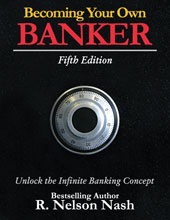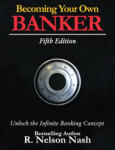submitted by jwithrow.
Before you can see why we believe so strongly in the Infinite Banking Concept (IBC) you must change the way you think about life insurance. The purpose of structuring an IBC participating whole life insurance policy actually has nothing to do with life insurance itself. Whole life insurance policies, when structured correctly according to the Infinite Banking Concept principles, are powerful vehicles for warehousing capital. This is what we are primarily interested in.
Typical IBC policies are structured such that 40% of the premium paid supports the base policy and 60% of the premium buys additional paid-up insurance. The large amount of premium going to purchase additional paid-up insurance serves to both grow your insurance policy (add to the death benefit) and it builds cash value much more quickly than standard whole life policies.
Your life insurance cash value is simply equity in the policy; it is not physical funds in an account. This gives life insurance cash value advantageous tax and legal treatment and it largely shields the cash value from creditors, plaintiffs, and corrupt government departments.
To illustrate this legal advantage think about what would happen if someone were to win a civil suit against you. The first thing that they would come for would be your bank accounts. The court could then force you to liquidate any investments in a standard brokerage account to pay the plaintiff’s claim and your capital base could be wiped out very quickly.
The court could not make you liquidate your life insurance cash value, however, because it is just equity in the policy. The primary way to access the cash value is to borrow against it and the court cannot force you to do this in the same way the court cannot force you to borrow against your home (domestic cases between spouses may be different as the court may determine one party to have an ownership claim already).
Now the court could enable the plaintiff to take an assignment of the life insurance in the amount necessary to satisfy the claim, but this would only pay out in the event of your death. Meanwhile, your cash value would continue to grow uninhibited and you would still have access to that capital at any time for any reason.
In addition to legal shelter, it would be much more difficult for the government to change the tax laws regarding life insurance cash value than for qualified retirement accounts. Qualified retirement plans (401k, IRA, etc.) are creatures of the tax code – these plans were specifically created within the IRS legal structure.
Life insurance, on the other hand, has been in existence for centuries in some capacity. The first American life insurance company was founded in 1787 and many life insurance companies that are prominent today were founded in the early-to-mid-1800’s. Contrast this with the IRS which was not unleashed on America until 1913.
While it is impossible to eliminate risk in this world, building capital in whole life insurance policies based on the Infinite Banking Concept is a way to mitigate legal risk and IRS risk, especially when compared to qualified retirement plans.
So now that we know our cash value is relatively safe from those who would steal it from us, let us examine the capital building merits of the IBC strategy.
Your cash value grows in two ways: when you pay the premium, and when the life insurance company pays a dividend. Paying premium into the policy guarantees that you will have a specific cash value at specific intervals in time.
Your life insurance agent can run illustrations for you depicting the cash value at the end of each year and this value is contractually guaranteed as long as premiums are paid. The guaranteed cash value illustration enables you to know, to the exact dollar amount, what your minimum cash value will be in a given year. This illustration depicts the cash value established by your premium payments (base+paid-up additions) and the figures assume that a dividend will never be paid.
Your agent can also run non-guaranteed cash value illustrations that estimate cash value based on the assumption that the company will continue to pay dividends at the current schedule. The non-guaranteed cash value illustration depicts the same contractual figures as the guaranteed illustration with the addition of annual dividends based on the current dividend rate. Dividends can add substantially to the cash value of the policy over time.
Whether or not dividends are actually paid out depends upon the company’s annual death benefit costs and investment performance. Mutual life insurance companies pay a dividend every single year unless they are in serious financial trouble and every single policy holder will receive a dividend if one is issued. Dividends are small in the policy’s early years, but can become quite substantial in the policy’s later years.
For example: we have an IBC policy illustration that estimates a dividend in the amount of $1,659 in year 5 of the policy and it estimates a dividend of $21,076 in year 25 of the policy. And just for fun: the dividend estimate is $69,951 in year 40 of the policy.
This same illustration depicts a guaranteed cash value of $17,288 and a non-guaranteed cash value on $17,667 after year one. After year five the guaranteed cash value is $95,936 and the estimated non-guaranteed cash value is $101,192. Year 25 depicts a guaranteed cash value of $804,112 and a non-guaranteed cash value of $1,048,247. And just for fun again: the guaranteed cash value after year 40 is $1,511,993 and the non-guaranteed cash value estimate is $2,662,316.
This illustration is based on an annual premium of $24,000 with 40% of that supporting the base policy and 60% buying additional paid-up insurance.
The point is you can generate an internal rate of return within the policy itself. This rate of return will be conservative and it will not wow you, but guess what? There is absolutely no risk to principal
whatsoever. This is huge!
This strategy allows you to know exactly how much capital you will have available to you at any particular point in the future so long as you keep making the premium payments. Once the policy is big enough you can also take policy loans to make the premium payments if need be. In fact, capitalizing a policy for as little as five or six years could be enough for policy loans to perpetually support the premium going forward.
The primary risk with this strategy is that the life insurance company could fail at some point in the future. This rarely happens, however, because mutual life insurance companies are very conservative organizations, unlike the Wall Street firms. The prominent mutual life insurance companies in operation today have survived the Great Depression as well as the crash of 2008. And they didn’t need any bail-outs or subsidies, either.
One reason for their strong financial history is that mutual whole life companies do not have shareholders. Accordingly, these companies do not need to resort to excessive risk taking to try to constantly pump up their stock price. Instead, the policy holders own the company and they are quite happy with a conservative risk appetite.
Additionally, the stronger life insurance companies in the industry have historically done a good job of taking over a failing company on the rare occasion when this has happened. In this scenario, the stronger life insurance company assumes all outstanding contracts of the failed company so as to maintain the conservative reputation of the industry.
Hopefully the power of the Infinite Banking Concept is starting to become apparent to you. Tomorrow we will look at some ideas on how to employ the IBC strategy as well as how you can mitigate the inflation risk inherent in standard life insurance products.
